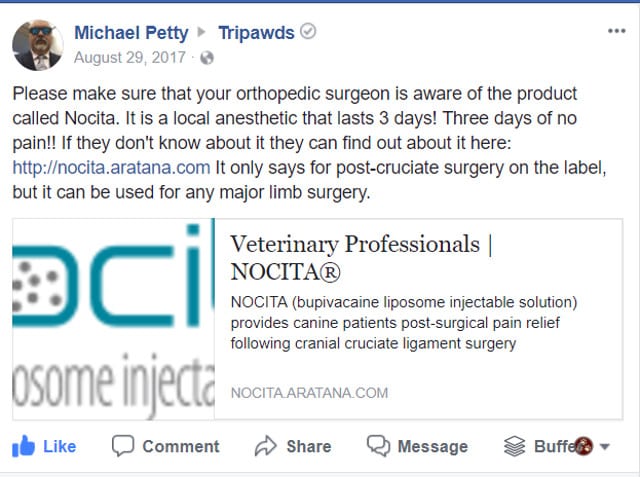In our experience, Tripawd dogs and cats come home from amputation surgery with varying degrees of pain control. We often wonder, is there one “recipe” standard for pet amputation pain control? Today, vet expert Dr. Robin Downing explains why there is not.
There is No “Recipe” for Pet Amputation Pain Control
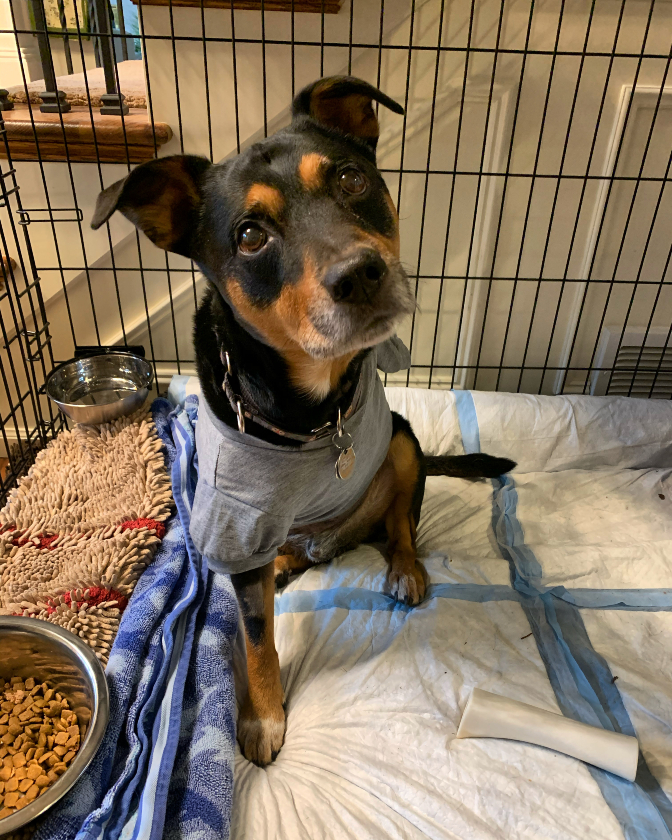
Last November we had the honor of speaking with Dr. Downing for over one hour! She generously shared so much information about pet amputation pain control with us, that we need to break down our conversation into multiple articles. Today is the first of several conversation experts to be published in the coming weeks.
In this part of our discussion, we ask Dr. Downing:
Is there a standard protocol for a dog or a cat coming home from amputation surgery as far as what type of medications they should receive and for how long?
Listen to Full Episode on Tripawd Talk Radio:
Pet Pain Management with Dr. Robin Downing
A transcript follows our conversation.
Here’s a transcript from our conversation with vet pain management expert Dr. Robin Downing:
Is there a recipe standard for pet amputation pain control?
TRIPAWDS: Is there a standard protocol for a dog or a cat coming home from amputation surgery as far as what type of medications they should receive and for how long?
Because it seems to be all over the mat. Yesterday we had somebody joined, his veterinarian for the cat said, “I’m not going to give you more than three days of pain medication,” and the member didn’t know what kind of pain medication they were going to get. They forgot to ask. But we see this all the time and I’m just wondering, is there a go-to resource where we can say to our veterinarian, “Can we talk about this protocol?”
And does AAHA have a protocol versus others not necessarily having? AAHA for those listening is the American Animal Hospital Association, the only accrediting …
DR. DOWNING: It’s a really great question. And in fact, there are two really good resources. They are open documents so they are available both to veterinarians and to really anyone who is interested.
The first is the American Animal Hospital Association, American Association of Feline Practitioners Pain Management Guidelines for Dogs and Cats, so the AAHA and AAFP Pain Management Guidelines for Dogs and Cats.
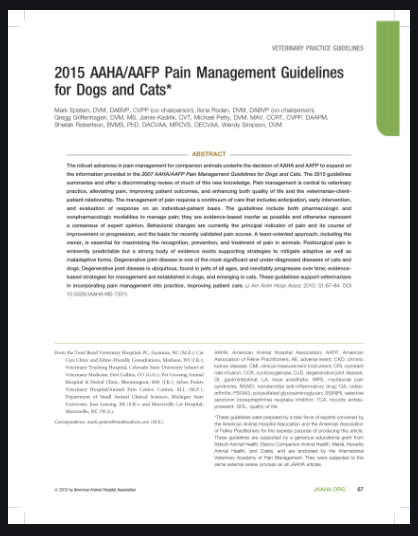
I had the privileged of co-chairing the first taskforce that created the first set of guidelines and the guidelines were updated in 2015. So we have a sort of a second set of guidelines and adjacent to those guidelines is a toolkit for implementation. And that’s also an open document. So that’s where you get into like building a protocol.
The Tripawd pain experience is individualized.
The short answer to your very specific question, is there a protocol for what we do post-op, the short answer is no, there isn’t. And part of that is because the pain experience and the pain phenomenon and how we caused that pain by the procedures we do is quite individualized. So it’s really challenging to just say in a cookbook fashion that this procedure do that. But the guidelines and the toolkit provides some guidelines and some strategies.
The second guideline that I love to reference and I use it all the time in my practice is the WSAVA, the World Small Animal Veterinary Association set of guidelines for pain management in cats and dogs. And that’s – I kind of mangled the title but if you just look up WSAVA pain management, it will come up.
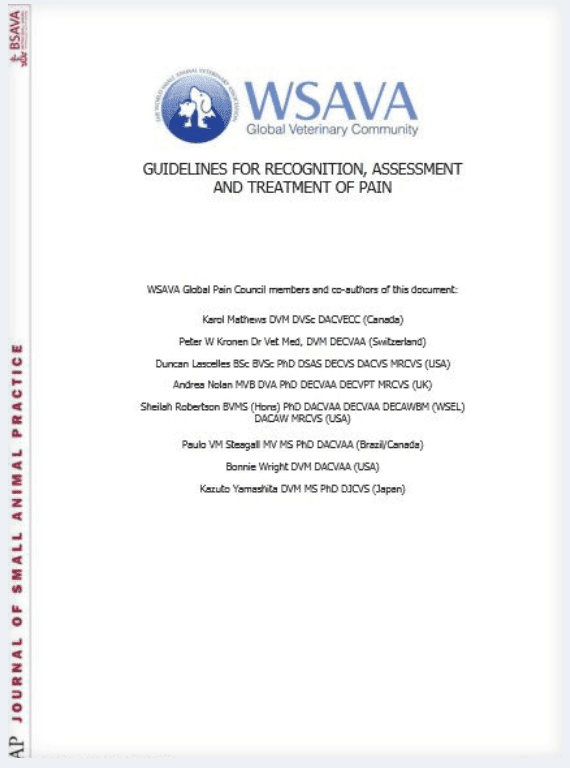
(See the WSAVA Website to download the guidelines in a variety of languages)
It’s a much more – it’s actually a more comprehensive – it’s a bigger document than the AAHA/AAFP guidelines. It is a little more robust, a little more in detail. There are some active links within the document to send people in different directions.
And so, those are two really good places to start. But then when it comes to actually executing a good pain management strategy, there are some really – I have some really smart colleagues who are really dedicated to doing good teaching about how to create a good pain management protocol in the post-operative period. The key being, it has to be multimodal. It really needs to be something that starts before it happens, during, and then follows up after a procedure.
What does pain control for amputation look like?
So let me give you some pieces that I think it would be useful for your listeners to know about.
Pre-op, what do we do to set the stage when we know that we have a surgery coming up? And let’s use the amputation as the example. I know that pre-op, I want my patient to have an opioid on board. And remember, I said that opioids aren’t absorbed orally by dogs and cats. So this is an injectable medication. This lets the nervous system already being temped down in anticipation of bad signals that are going to come in from the actual surgery itself.
Intra-op, I’m going to use an opioid in what we call a CRI or continuous rate infusion. And a continuous rate infusion used to be referred to as a constant rate infusion, but it’s really not constant. It’s continuous. Meaning, drip, drip, drip, small volumes of a narcotic like fentanyl for instance could enter the body on a continuous basis that we can adjust up or down depending on the need of the patient.
So there is in this situation circling back to can we have panting as a side effect of medication? This is the one situation where a pain medicine can cause panting or restlessness, and that is a situation where the opioid disorients the animal. So fentanyl is the one that I go to. If I am using a continuous rate infusion of fentanyl and my patient gets a little restless, first thing I’m going to think is maybe I need to increase my medication because they might be painful.
Is the opioid having an adverse effect? Does it need adjustment?
But the second thing I have to consider is, could they be restless because the opioid is having an adverse effect? And there’s a little trick we can do with a medication called naloxone that you may have heard of because the ambulances are now carrying naloxone to help people who have had a heroin overdose. It reverses the opioid.
I can do a small dose of naloxone and if my patient gets better in their mentation, I know they’re having an adverse effect to the narcotic. If it doesn’t change the behavior, I know they are more painful.
Then I can adjust their medication up. So that’s intra-op. And then post-up when they’re in my hospital, I’m going to have that continuous rate infusion. But then when they – as part of my procedure, and I have to confess that my patients now had their amputations at the hands of a very skilled surgeon who can do an amputation in the time it takes me to take ovaries out of the dog. She is really good. She is really fast. Fast doesn’t equate to good but the advantage to a speedy surgery is less time under anesthesia, fewer drugs involved. I really want my patient to have that experience.
And one of the things that she will do is to use that drug called Nocita. Nocita is a long-acting local anesthesia. It’s a long-acting bupivacaine which is a local anesthesia and it can give us up to three days of good pain relief at the site of the amputation.
Now, it’s important for your listeners to realize that Nocita was developed specifically for TPLO surgery, some knee surgery in dogs. So when we talk about using it for blocking pain from an amputation, it’s extra label. It’s off the label that the FDA approved. However, we now know that it is so effective that it would be ridiculous for a surgeon to withhold that tool to provide that dog with a bridge of three days of local anesthesia at the site of an amputation. That’s like a miracle.
Other pet amputation pain control steps and therapies
In my hands, those patients who go to my surgeon friend to have their surgery, they come home with a nonsteroidal anti-inflammatory drug which comes to the pain from one direction and they get gabapentin which comes to the pain from a different direction to block the nerve pain, but then there are also physical medicine things that we do. So I teach my clients how to use ice in the first four days and how to use heat in the days following.
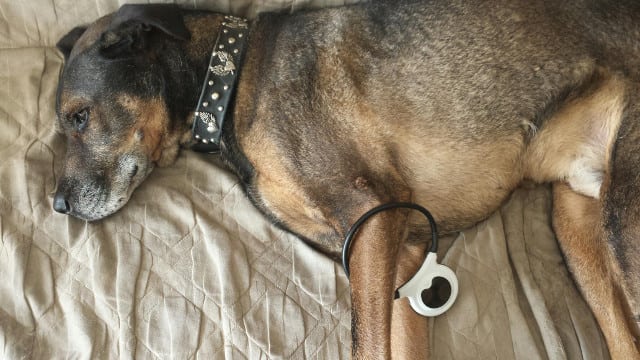
I teach my clients how to use a technology called Targeted Pulsed Electromagnetic Field therapy or the Assisi Loop. Here, we have a tool that my clients can use every day, every day, every day at home to decrease pain, to decrease inflammation. It’s something tangible that they can do in between times they see me because the other things that I’m going to do for that patient include photobiomodulation with therapeutic laser therapy because I know that I can speed healing.
END OF THIS SECTION
Meet Our Expert, Dr. Robin Downing
Dr. Downing is one of the world’s best veterinary pain management experts. She is the 2020 recipient of the prestigious American Veterinary Medical Association’s Bustad Companion Animal Veterinarian of the Year Award. The award is one of veterinary medicine’s highest honors, recognizing the outstanding work of veterinarians in protecting and promoting the human-animal bond.
She is the founder, owner and medical director of the Downing Center for Animal Pain Management, and the owner and medical director of AAHA-accredited Windsor Veterinary Clinic, both in Windsor, Colo.
In 2005, Dr. Downing became only the third veterinarian in the world to become credentialed as a diplomate in the American Academy of Pain Management. She went on to create the International Veterinary Academy of Pain Management, the first interdisciplinary pain management organization in veterinary medicine, and to help develop the credential of Certified Veterinary Pain Practitioner. She is also a diplomate of the American College of Veterinary Sports Medicine and Rehabilitation.
